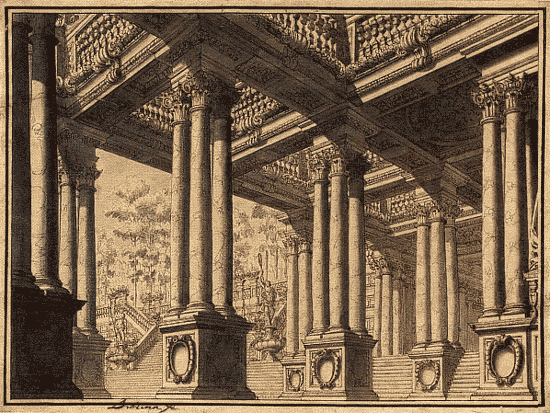If Fernando Galli Bibiena, famed scenographer, designer extraordinaire of endless, receding, Baroque pillared symmetries, with trick halls and mirage-like backdrops—

—were cloned next year, raised in Hollywood, and hired to remake Total Recall, he’d probably make something like this:



It’s Tokyo’s massive “G-Cans Project,” a subterranean system of polished concrete viaducts built “for preventing overflow of the major rivers and waterways spidering the city.”
This emergency overflow-sewer is apparently “the largest in the world,” with “five 32m diameter, 65m deep concrete containment silos which are connected by 64 kilometers of tunnel sitting 50 meters beneath the surface. The whole system is powered by 14000 horsepower turbines which can pump 200 tons of water a second.”

The G-Cans Project reveals the quasi-mythic splendor of grandiose civic infrastructure, something the United States is ridding itself of entirely—yet also something Japan is now all but entombed within.
A “construction state”—or doken kokka—has effectively taken over the Japanese economy, according to Gavan McCormack in the New Left Review. The doken kokka, McCormack writes, “is opaque, unaccountable, and therefore hard to reform. Essentially, it enables the country’s powerful bureaucrats to channel the population’s life savings into a wide range of debt-encrusted public bodies—those in charge of highways, bridge-building, dams and development initiatives,” and that means “promising new public-works projects,” thus “concreting the archipelago.”
Under construction right now, in fact, is “a grandiose [national development plan] calling for the construction of new railway lines, express highways, airports, information systems, no less than six new bridges between the islands, large dams and nuclear installations and, last but far from least, a new capital city… to take over many functions from Tokyo.”
The article is pretty amazing, actually, even shocking—though I do have to say that some of the projects it describes would be an engineer’s dream. But it comes with the realization that all this frenzied global construction may be more than just a bubble—see recent analyses of China’s own building boom, for instance—or Dubai—but a kind of hysteria, a building-pathology.
One wonders, in fact, if there might be a disease, something Freud discovered, a neurosis of some kind: suddenly you start building things, and you don’t stop building things. You move beyond talking—building, building, always building—and soon you’re like the father in Close Encounters of the Third Kind, with mashed potatoes all over your hands and there’s a mountain in your living room. That, or you’ve just built the world’s largest sewer.
(See earlier on BLDGBLOG).